Don't Miss These Five Maritime Gems
The Chesapeake Bay is rich in boating opportunities and maritime history. Throughout Maryland and Virginia there are several maritime museums, varying in scope and size, that allow us to learn about and celebrate that rich history.
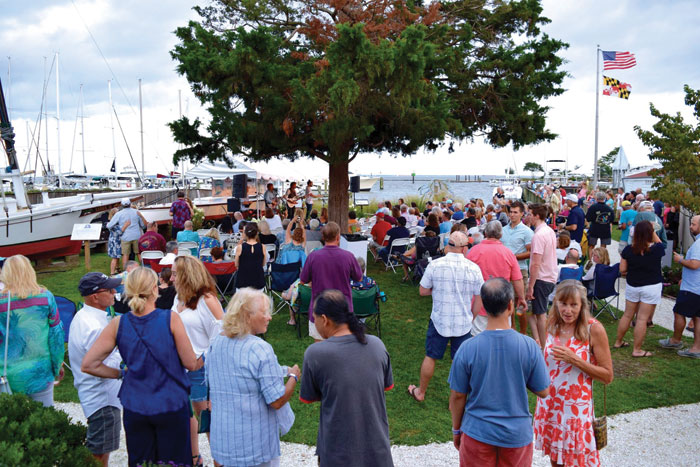
1. Annapolis Maritime Museum and Park
The Annapolis Maritime Museum and Park (AMMP) is housed in the historic McNasby Oyster House, the perfect setting to educate the public on the region’s proud maritime history, the ecological diversity of the Bay, and the environmental impacts of humans due to over-harvesting and depletion of the oyster population. The waterfront campus includes three transient piers and an adjacent beachside park—the only one in Annapolis—where visitors can launch personal paddlecraft such as kayaks and stand-up paddleboards. Each year the museum hosts several key events, including a winter lecture series, an oyster roast and sock burning in March, the very popular Tides and Tunes Summer Concert Series, and of course the annual Boatyard Beach Bash fundraiser.
Located across Back Creek from AMMP’s McNasby Campus is the museum’s newest addition, the Ellen O. Moyer Nature Park Campus. This renovated, 12-acre park accommodates AMMP’s ever-expanding education programs, helping to further develop the curriculum to include natural sciences through hands-on activities.
The Annapolis Maritime Museum is also one of four partners in a consortium that took over ownership of the iconic Thomas Point Shoal Lighthouse. The Museum joined the Chesapeake Chapter of the U.S. Lighthouse Society, the City of Annapolis, and Anne Arundel County to manage and preserve this beloved National Historic Landmark. Built in 1875, the Thomas Point Shoal Lighthouse is the last screwpile lighthouse on the Bay still in its original location. From June through October, guests can take a boat ride to the lighthouse for a docent-led tour.
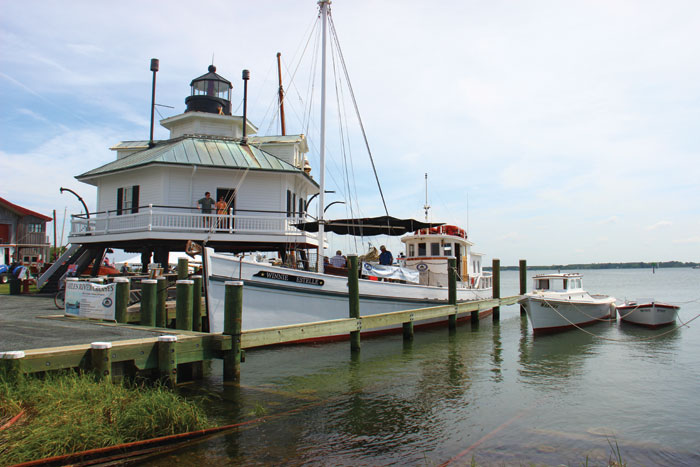
2. Chesapeake Bay Maritime Museum
Established in 1965, the Chesapeake Bay Maritime Museum (CBMM) is an educational organization dedicated to preserving and exploring the history, environment, and culture of the entire Chesapeake Bay region, and making this resource available to all. Located in St. Michaels, MD, CBMM’s campus includes a floating fleet of historic boats, 12 exhibition buildings, and changing special exhibitions, all set on the waterfront of the Miles River and St. Michaels’ harbor. The museum serves more than 75,000 guests each year, and its collection of historic Chesapeake Bay watercraft—maintained by shipwrights and their apprentices in the museum’s working shipyard—is the largest in existence.
There is always something new to explore at CBMM, such as the living shoreline along the waterfront, the historic Tolchester Beach Bandstand (circa 1880) and the Point Lookout fog bell tower (circa 1888); and many other permanent exhibits that call CBMM home. Guests can step aboard the oyster harvesting skipjack E. C. Collier and enter the world of the working watermen of the Chesapeake Bay or try their hand at harvesting seafood at Watermen’s Wharf, a recreated crabber’s shanty. There is a history of waterfowling exhibit, along with a Maryland crab meat company exhibit, and of course the Hooper Strait Lighthouse, built in 1879 and moved to CBMM in 1966.
Besides its permanent and rotating exhibits, there always seems to be a fun event unfolding on the museum’s campus. We’ve just missed the Mid-Atlantic Small Craft Festival and the annual October OysterFest. Next year, mark your calendars for the annual Blessing of the Fleet in April, the Antique and Classic Boat Festival and Arts at Navy Point held every Father’s Day Weekend (a SpinSheet favorite!), Big Band Night to celebrate Independence Day, Watermen’s Appreciation Day in August, and the Charity Boat Auction held Labor Day weekend.
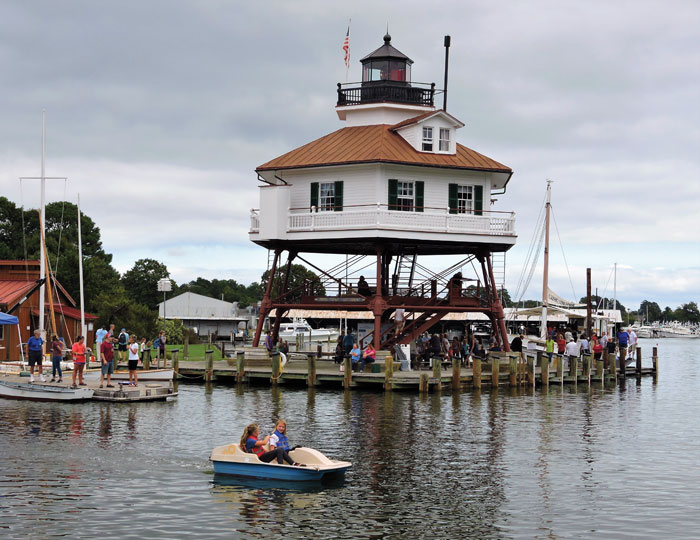
3. Calvert Marine Museum
The Calvert Marine Museum (CMM) in Solomons, MD, invites guests to explore the unique story of the Chesapeake Bay, from our Prehistoric past to our maritime heritage and natural environment. A particular draw of CMM is the Paleontology Gallery with a life-size diorama that recreates the world of the Miocene and a 35 foot skeletal restoration of the extinct Miocene giant white shark, Carcharocles megalodon. At the end of the gallery visitors will find the fossil preparation lab where trained volunteers prepare fossils found along the beaches of Calvert Cliffs. At the touch tank, interpreters are always on hand to introduce guests to some of the curious creatures in the Chesapeake Bay and nearby Atlantic Ocean including horseshoe crabs, diamondback terrapins, sea stars, and prickly sea urchins.
Also of interest, the Maritime History Gallery, the scenic Marsh Walk, the screwpile Drum Point Lighthouse (decommissioned in 1962 and moved to CMM in 1975), the historic buyboat Wm. B. Tennison which offers sightseeing cruises around Solomons Island, the skipjack Dee of St. Mary’s, and a host of changing exhibits (including Dinosaurs of Maryland, now through December 31). Off-site, the museum maintains the J.C. Lore & Sons Oyster House, a national historic landmark located less than a mile away, and the Cove Point Lighthouse which is open to the public as a weekly vacation rental. Throughout the year, CMM hosts many events, including children’s activities, lectures, and the very popular Waterside Concert Series.
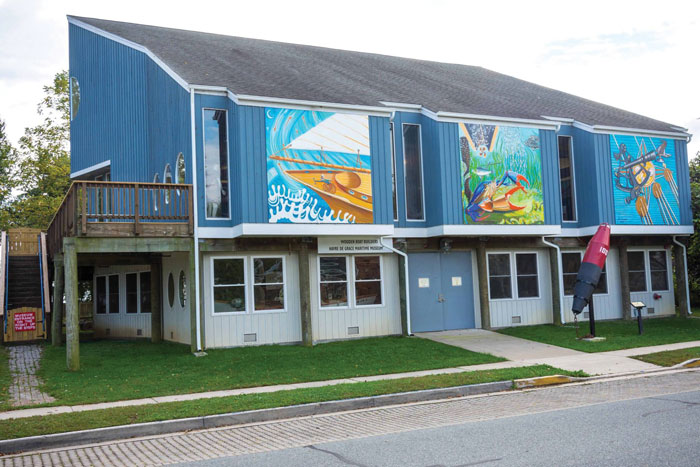
4. The Havre de Grace Maritime Museum
The Havre de Grace Maritime Museum in Havre de Grace, MD, is situated where the Susquehanna River meets the upper Chesapeake Bay, and tells the story of the region’s rich maritime history. The museum was established in 1988, and in 2015, a brand new Environmental Center and Classroom was unveiled to better educate the community about environmental estuarine, wetland, and upland watershed science and environmental stewardship.
Behind, and immediately adjacent to the museum, is a small tidal wetland, crossed by the Havre de Grace Promenade. The Museum is undertaking the restoration of the wetland and shoreline to create a “living classroom” for its educational programs, and for the enjoyment of the many visitors who come to walk the Promenade.
On the ground floor of the museum, the Boat Shop renovates and restores old wooden boats and builds replicas of early and mid-20th century classic wooden boats. Volunteer boat builders are always welcome to join the team; experience is not necessary. Throughout the year, the museum also hosts a series of lectures, environmental film screenings, a summer concert series, boating classes taught by the U.S. Coast Guard Auxiliary, and Environmental Center programs for children and young adults. Coming up is The Great Havre de Grace Oyster Feast November 17. Tickets are $55 per person for this community gathering in support of the museum.
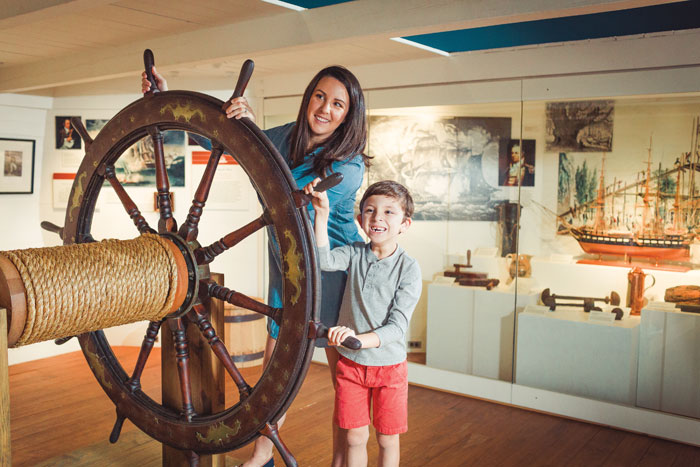
5. The Mariners’ Museum and Park
The 550-acre Mariners’ Museum and Park in Newport News, VA, is an urban oasis, home to the 167-acre Lake Maury and the Noland Trail (a five mile shoreline trail with 14 bridges) and over 90,000 square feet of exhibition galleries, including the prestigious International Small Craft Center, and the award-winning USS Monitor Center. The Small Craft Center features nearly 150 boats from 42 countries, and is one of the few truly internationally focused collections in the world. The Monitor Center exhibition and conservation lab houses 210 tons of artifacts from the Civil War ironclad Monitor, which were recovered from NOAA’s Monitor National Marine Sanctuary. The Mariners’ Museum Library and Archives is home to over 78,000 books; 800,000 photographs, films, and negatives; and over one million pieces of archival material, making it the largest maritime library in the Western Hemisphere.
Some exciting current exhibitions include: Answering America’s Call: Newport News in World War I; Sailor Made, featuring items made by sailors or artisans at sea; and Speed and Innovation in the America’s Cup, which is home to the actual AC72 catamaran that won the 34th America’s Cup in 2013, donated to the museum by Oracle Racing.
The goal of the Mariners’ Museum has always been to connect people to the world’s water, “because through the waters—through our shared maritime heritage—we are connected to one another.” Apart from its many exhibitions, the museum hosts a variety of events and learning activities aimed at fostering its mission. Maritime Mondays, for example, are designed for children 18 months to eight years and include engaging learning activities, story time, and a craft (free with museum admission). There are online learning opportunities on a variety of topics, and Civil War Round Tables are held Friday afternoons for anyone interested in stimulating historical discussions.
Some Smaller Museums
Captain Salem Avery Museum, Shady Side, MD.
Deltaville Maritime Museum, Deltaville, VA.
Richardson Maritime Museum, Cambridge, MD.
The Ward Museum of Wildfowl Art, Salisbury, MD.




